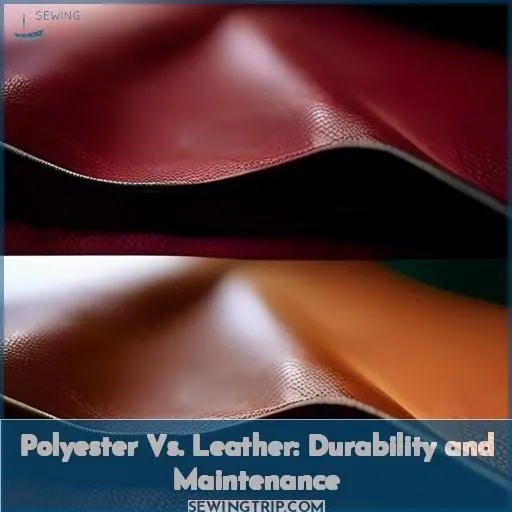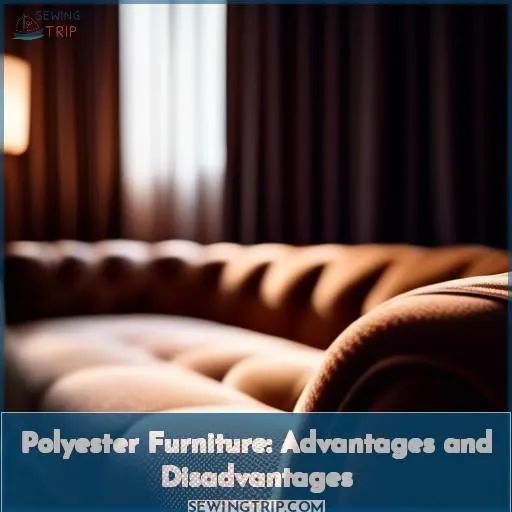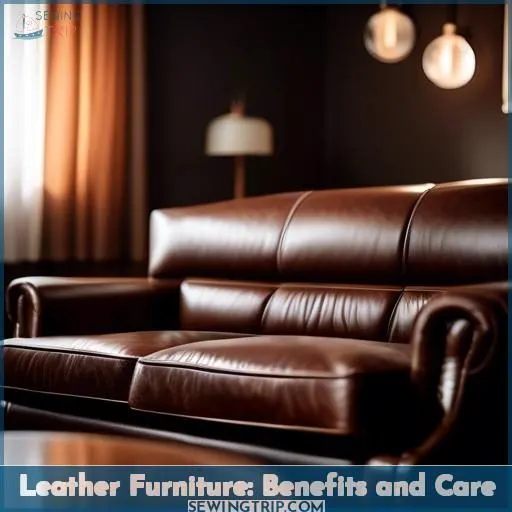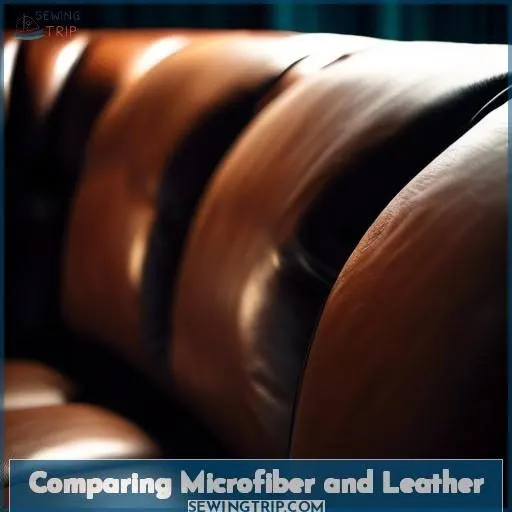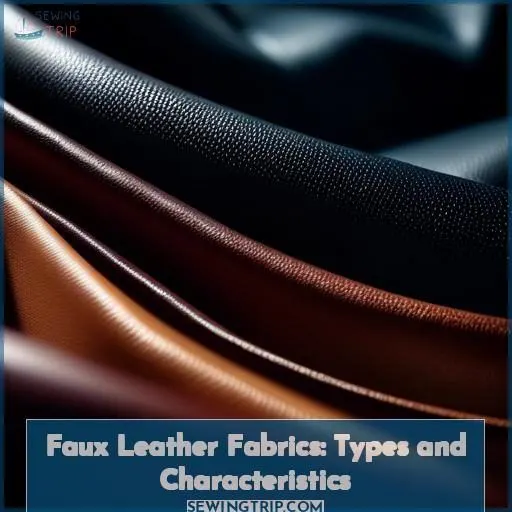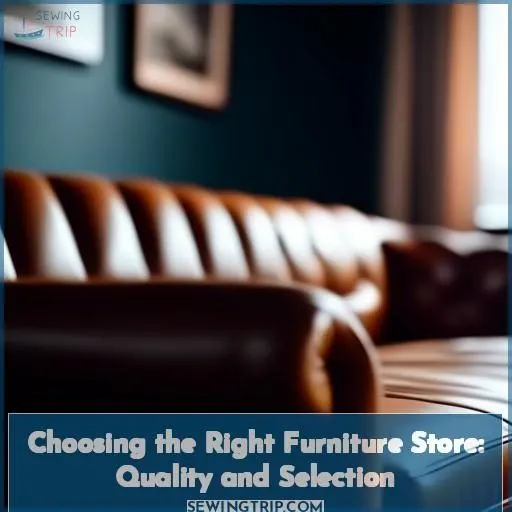This site is supported by our readers. We may earn a commission, at no cost to you, if you purchase through links.
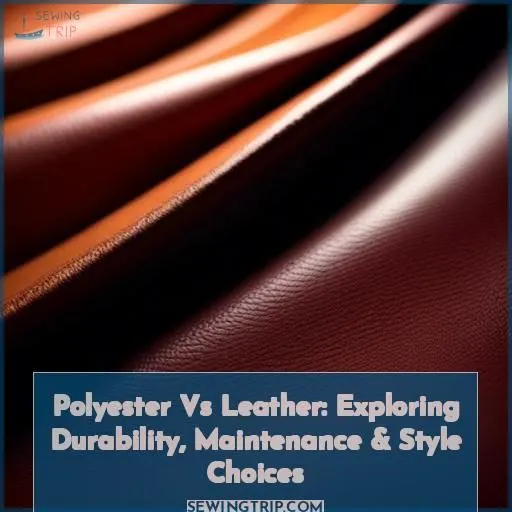
When comparing polyester and leather, the key differences lie in their durability and maintenance requirements. Polyester is generally more stain-resistant, easier to clean, and less prone to scratches, making it a lower-maintenance option.
In contrast, leather offers timeless elegance and unparalleled durability, but may require more careful care to preserve its appearance over time. Faux leather fabrics, such as PU and PVC, can provide some of the benefits of genuine leather at a lower cost, but may not match its durability.
To determine the best choice for your needs, consider factors like usage, desired aesthetic, and your willingness to commit to regular care.
Table Of Contents
- Key Takeaways
- Polyester Vs. Leather: Durability and Maintenance
- Polyester Furniture: Advantages and Disadvantages
- Leather Furniture: Benefits and Care
- Comparing Microfiber and Leather
- Faux Leather Fabrics: Types and Characteristics
- Choosing the Right Furniture Store: Quality and Selection
- Frequently Asked Questions (FAQs)
- Conclusion
Key Takeaways
- Polyester is generally more stain-resistant, easier to clean, and less prone to scratches, making it a lower-maintenance option.
- Leather offers timeless elegance and unparalleled durability, but may require more careful care to preserve its appearance over time.
- Faux leather fabrics, such as PU and PVC, can provide some of the benefits of genuine leather at a lower cost, but may not match its durability.
- When selecting furniture, factors such as longevity, upkeep, pet-friendliness, cost comparison, adaptability in style, and environmental impact should be considered.
Polyester Vs. Leather: Durability and Maintenance
When selecting furniture, longevity and upkeep are key considerations. Let’s delve into the comparison of polyester and leather durability, examining their resistance to stains, pet friendliness, cost comparison, and adaptability in style.
Leather inherently resists pet hair and grime, making it a suitable option for pet owners. However, it’s more prone to scratches and may require more maintenance than polyester. Leather is also more expensive and offers a limited color palette. Conversely, polyester is stain-resistant and easy to clean, making it a practical choice for homes with children or pets. It’s also less costly than leather and versatile for both upholstery and drapery.
Regarding style, leather exudes luxury and comfort, while polyester provides comfort and is available in diverse styles. Leather is more durable than polyester, but maintenance can be more demanding, and it’s less resistant to spills and stains. Polyester is more heat-resistant and less susceptible to damage from spills or mishaps.
Environmentally, leather is biodegradable as a natural material, while polyester is derived from synthetic fibers and isn’t biodegradable. However, recycled polyester is available as a more eco-conscious option.
Polyester Furniture: Advantages and Disadvantages
Polyester furniture offers a range of advantages for those seeking durable, low-maintenance pieces.
Compared to leather, polyester is more resistant to wrinkles and stains, making it an excellent choice for households with children or pets.
It’s also less expensive, offering a cost-effective alternative for those seeking style versatility.
However, polyester may not provide the same luxurious texture as leather.
Its environmental impact is a concern for some.
Additionally, while polyester is fire-resistant, it may not be as comfortable as leather for extended periods.
Consider your personal preferences and lifestyle when choosing between these two materials for your furniture.
Leather Furniture: Benefits and Care
Leather furniture offers timeless elegance and unparalleled durability, but requires diligent care to maintain its luster. While genuine leather demands routine conditioning and prompt cleaning of spills, faux leather alternatives provide a lower-maintenance option, though they may lack the authentic texture and resilience of real leather over time.
Polyester Durability
Polyester is a durable material, outlasting leather in terms of wear and tear and resistance.
It’s less likely to be damaged by spills or accidents, making it a better choice for households with children or pets.
The synthetic fibers in polyester are less likely to break down over time. They’re also less likely to be damaged by spills or other accidents.
This durability is one of the main advantages of polyester, which is why it’s often used for furniture and other home products.
Leather Maintenance
Essential maintenance is vital for safeguarding the longevity and aesthetic allure of leather furniture. Regular dusting and vacuuming, timely spill removal, monthly gentle soap and water cleaning, and annual conditioning with a leather protector are essential practices. Leather’s durability and style options make it a popular choice, but its vulnerability to cracking and scratches necessitates meticulous care.
Faux Leather vs. Genuine Leather
Faux leather and genuine leather each possess distinct qualities and advantages. Faux leather, composed of materials such as polyurethane or polyvinyl chloride, is generally more budget-friendly and easier to upkeep than genuine leather. It also exhibits increased resistance to staining and reduced sensitivity to environmental factors** like sunlight and temperature fluctuations. However, faux leather has a tendency to deteriorate more quickly than genuine leather and is less breathable, potentially causing increased perspiration.
Conversely, genuine leather, sourced from animal hides, is renowned for its inherent beauty and durability. With appropriate care, it has the potential to last for decades and develops a distinctive patina over time. Genuine leather is also more comfortable due to its breathability and ability to adapt to body temperature. However, it comes with a higher price tag than faux leather and necessitates greater maintenance to preserve its beauty and durability.
When evaluating faux leather and genuine leather, it’s crucial to weigh factors such as cost, durability, maintenance, and personal preferences. Faux leather may represent a more affordable and low-maintenance solution for those seeking a synthetic alternative, while genuine leather offers a more natural and durable option for those willing to invest in a higher-priced, longer-lasting material.
Comparing Microfiber and Leather
When contrasting microfiber and leather, there are several critical distinctions to contemplate. Microfiber is an artificial substance renowned for its affordability and resilience. It’s also effortless to maintain and provides a wide range of styles, making it a prevalent selection for living room furnishings.
Conversely, leather is a natural substance valued for its opulent appearance and texture. It’s also remarkably durable due to the inherent collagen fibers present in bovine hides. However, leather may be more costly and demands more meticulous upkeep to avert cracking and blemishes.
Certain popular forms of faux leather encompass PU faux leather fabric, PVC faux leather fabric, bi-cast leather, and bonded leather; however, they’re less durable than genuine leather and may fissure or peel with time.
Faux Leather Fabrics: Types and Characteristics
Faux leather fabrics come in various types, each with its own characteristics and cleaning requirements. Understanding these differences is essential for maintaining the longevity and appearance of your faux leather items.
- PU Faux Leather Fabric: Polyurethane (PU) is a type of synthetic leather that’s soft, flexible, and durable. It’s often used for clothing, furniture, and accessories. To clean PU faux leather, use a mild soap solution and a soft cloth. Avoid using harsh chemicals or abrasive materials, as they can damage the surface.
- PVC Faux Leather Fabric: Polyvinylchloride (PVC) is another type of synthetic leather that’s known for its durability and resistance to water and stains. To clean PVC faux leather, use a damp cloth with a mild soap solution. Be sure to rinse the surface thoroughly to remove any soap residue.
- Bi-Cast Leather: This type of faux leather is made by bonding two layers of PVC together. It’s often used for high-quality faux leather products, such as jackets and bags. To clean bi-cast leather, use a soft cloth and a mild soap solution. Avoid using harsh chemicals or abrasive materials, as they can damage the surface.
- Bonded Leather: This type of faux leather is made by bonding leather scraps together with a synthetic material, such as PVC. It’s often used for lower-priced faux leather products. To clean bonded leather, use a soft cloth and a mild soap solution. Avoid using harsh chemicals or abrasive materials, as they can damage the surface.
When cleaning faux leather, remember to avoid using harsh chemicals, as they can cause the material to peel or crack. Instead, opt for mild soap solutions and soft cloths. Regular dusting and wiping with a damp cloth can help maintain the appearance of your faux leather items. For more stubborn stains, consider using a vinegar solution or a specialized faux leather cleaner. Always refer to the manufacturer’s instructions for specific cleaning recommendations.
Choosing the Right Furniture Store: Quality and Selection
When choosing a furniture store, pay close attention to the quality of their products and the breadth of their selection. You’ll want to work with a store that offers both high-quality, durable furniture and a wide variety of styles and materials to suit your needs.
Quality Comparison
When choosing furniture, it’s not just about picking a style; it’s a cost comparison chess game. You’re weighing comfort level, environmental impact, and warranty coverage against purpose, tensile strength, and heat tolerance.
Selection Differences
When choosing a furniture store, consider the style differences between polyester and leather. Polyester offers a wider range of color choices and is often less expensive. Leather, on the other hand, is known for its luxurious look and feel, but can be more expensive.
Look for a store that offers a variety of styles and materials, like a San Diego furniture store on Kettner Boulevard.
Customer Experience
When choosing a furniture store, consider customer preferences, store atmosphere, and the expertise of salespeople. Look for financing options and warranty protection. Quality thread brands like American Elfird and Coates are recommended for consistent performance. Avoid bad spools of thread and consider the dying process’s impact on stiffness.
Frequently Asked Questions (FAQs)
What is the difference in price point between polyester and leather furniture?
Man, you’re really gonna be bowled over by the sheer difference in price** between polyester and leather furniture! Polyester is a steal, while genuine leather will set you back a pretty penny. But hey, you get what you pay for, right?
How does the durability of microfiber compare to leather?
Microfiber is generally more affordable than leather, but leather is more durable and has a more luxurious look and feel. The choice comes down to your budget, lifestyle, and personal preferences. Test them out before deciding.
What are the advantages of using a leather protectant on leather furniture?
Well, the cat’s out of the bag – using a leather protectant keeps your couch looking sharp and lasting longer. It’s a real game-changer, shielding against wear, tear, and stains. Treat your leather right, and it’ll be the cat’s meow for years to come.
How does the cleaning process differ between polyester and leather furniture?
With polyester, you just need a quick wipe-down with a damp cloth. Leather, on the other hand, requires more TLC – regular dusting, vacuuming, and monthly cleaning with a mild soap solution. Conditioning is a must once a year to keep it supple.
What factors should be considered when choosing between a polyester and leather couch for a household with pets?
Picture a playful pooch bounding across a plush polyester sofa – no worries, as polyester’s durable, wrinkle-resistant nature shrugs off paw prints. Leather, though luxurious, demands more care and may not withstand rambunctious pets as well.
Conclusion
Regarding the polyester versus leather debate, you possess the authority to determine which material aligns optimally with your lifestyle and aesthetic predilections. Each alternative presents discrete benefits – polyester’s ease of maintenance contrasting with leather’s enduring sophistication.
By evaluating the durability, care requirements, and personal style associated with polyester and leather, you can arrive at an informed decision that harmonizes with your distinctive requirements and aspirations.
The choice ultimately rests in your hands, akin to the obverse and reverse of a monetary unit.

